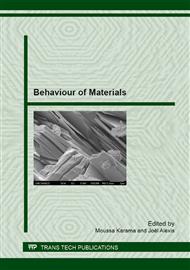p.63
p.71
p.79
p.85
p.91
p.99
p.107
p.115
p.127
Thermomechanical Characterization of a Mortar Reinforced by Animal Fibers
Abstract:
To meet the needs always more accurate and demanding in the construction industry, mechanical and thermal or acoustic features of building materials have known significant improvements over the last two decades. Researchers in materials science and civil engineering are constantly listening to the industry and continue to innovate in this field. The current trend is the search for new materials, called intelligent, where several properties as mechanical and physico-chemical are combined. In our case, the aim was to develop a new construction material reaching the construction standards, --- i.e. with acceptable mechanical properties --- but which is also able to perform other functions such as thermal insulation or sound insulation. To do this, we chose to strengthen a cement mortar with natural fibers obtained from poultry feather. A physical and chemical stability behavior is obtained thanks to a treatment performed before their incorporation into the composite matrix. The fibers are introduced in a mortar matrix as a substitute for mineral or synthetic fibers which are traditionally used for this purpose. The cylindrical and prismatic specimens were then prepared with the composite in order to determine the mechanical characteristics of this composite. Compression tests and three-point bending were carried out for this purpose. To determine the thermal conductivity of composites, several plates with different percentages of fiber, whose size is 300x300x10 mm3, was chosen in order to be adaptable to the experimental device, were fabricated.
Info:
Periodical:
Pages:
91-98
Citation:
Online since:
April 2013
Authors:
Price:
Сopyright:
© 2013 Trans Tech Publications Ltd. All Rights Reserved
Share:
Citation:


